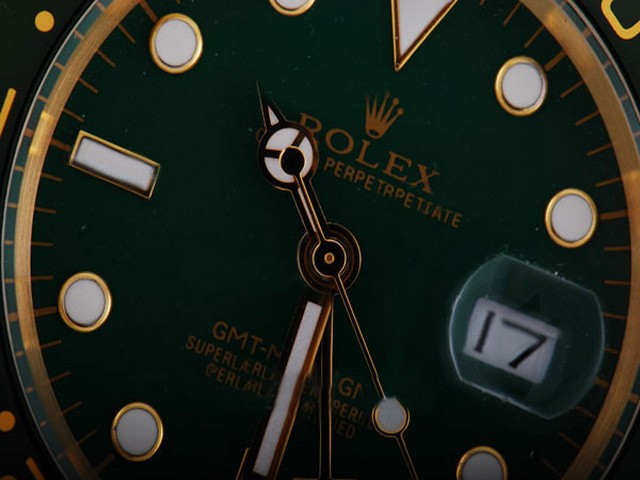Before you set your Rolex Explorer II to function as a GMT watch, the first thing to note is that the winding crown has three different positions, and depending on the position, rotating the crown will engage different parts of the movement.
- Position 1: Manual winding position; the crown is unscrewed from the case and rotated to wind the fake Rolex watch.
- Position 2: Local time setting position; the crown is pulled out to a notch, the second hand is still running, and the local hour hand jumps forward or backward when the crown is rotated.
- Position 3: Reference time setting position; the crown is pulled out all the way to the second notch, the second hand stops running and both the hour and minute hands move when the crown is rotated.
When you set the reference time (home time) on your watch, the first thing you will want to do is align all the hands, as synchronizing them now will help make the rest of the process easier. To do this, simply pull the winding crown all the way out to position 3 and then rotate the hands so that they are aligned with the 12 o’clock marker.
From here, you will keep rotating the hands until the 24-hour hand and the minute hand shows your desired reference time. Remember that this will always be a 24-hour format, with the 24-hour hand pointing to the corresponding value of the 24-hour scale on the external bezel.
Once you have set the reference time on your fake watch, the next thing you want to do is set the date. To do this, press the winding crown down a notch to position 2. In this position, the second hand will resume running, and rotating the winding crown will cause the local 12-hour hand to jump forward or backward in one-hour increments.
The date changes when the 12-hour hand passes the midnight hour. Continue rotating the winding crown until the correct date appears in the window at 3 o’clock. Remember that since the local hour hand displays the time in 12-hour format, the date display changes only once for every two revolutions of the local hour hand around the dial.
While leaving the winding crown in position 2, continue to advance the local 12-hour hand until it indicates the correct time for your current position. Since this is a standard 12-hour hand, it is important to note during this step whether the local time is displayed against the dial for the AM or PM hours.
Once the local time has been set, press the winding crown back completely and screw it back into the case. This will ensure that your Rolex Explorer II remains moisture and tarnish-resistant.
When you set your replica Rolex Explorer II to watch correctly as a GMT watch, you can read the local time via the normal hour and minute hands on the dial, while the time at your home or reference location is displayed by the 24-hour hand relative to the bezel. This way, you can quickly see two different time zones at the same time and, because your reference time is always displayed in 24-hour format, there is no confusion about the AM or PM time even if your reference time is on the other side of the world.
An additional benefit of this style of GMT watch is that its jumping local hour hand is perfect for travel. For example, let’s say you’re flying from Los Angeles to Switzerland, and you’re stopping in New York for a few hours. New York City is three hours ahead of Los Angeles, so when you land on the East Coast for a stopover, simply unscrew the crown and jump the local time hand forward three hours so your watch will show the correct time for your current location.
When you land and change planes in Switzerland, simply jump the local hour hand forward again and your watch will reflect the time at your new location. When adjusting the local hour hand, the seconds and minutes hands are still moving, so adjusting the time zone will not affect the precision of your watch’s timekeeping. In addition, the time in your home city (Los Angeles) will always be indicated by your 24-hour hand, so you won’t wake everyone up in the middle of the night when you accidentally call home by accidentally mixing up the AM and PM hours.

